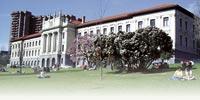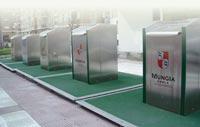Agenda 21 in Bizkaia at a good pace
2005/05/01 Galarraga Aiestaran, Ana - Elhuyar Zientzia Iturria: Elhuyar aldizkaria

The Provincial Council of Bizkaia values the progress of Agenda 21 in Bizkaia. It should be noted that industrial development had a great influence in Bizkaia. It allowed economic progress, but, incidentally, the environment was seriously affected in more than one place. So, in the 1970s, some realized that it was impossible to follow that path. The concept of sustainable development was born.
Bizkaia was not, of course, the only territory punished by industrial activity. In 1968 representatives from 30 countries concerned about the environmental impact of economic development and industrial activity met in Rome. There the seed of sustainable development was sown and gradually people became aware of the importance of the environment. There was no other remedy: it developed economically but taking care of nature.

In Bizkaia, measures were also adopted to reconcile economic development with the care of the environment, making Agenda 21 an indispensable instrument. The concept was born at the United Nations conference held in Rio de Janeiro in 1992. One of the highlights of the conference was the incorporation of the social dimension into sustainable development. Since then, they claimed the need to build the future on three pillars: economic development, environmental preservation and social development.
They also indicated that the way to do the work had to be changed: instead of from top to bottom, they thought it was better to build from bottom to top. Therefore, citizen participation is fundamental in Agenda 21.
Local
In Bizkaia, the first municipality to work on Agenda 21 was Alonsotegi. The issue was addressed in 1999, convinced that this was the best way forward. The following year the Aalborg Charter is signed and the environmental quality audit is carried out. The study identified the strengths and weaknesses of the people. A diagnostic action plan was subsequently designed and sustainability indicators were selected. Thanks to them you can check if they are on the right track to achieve the marked goals.

The other municipalities of Bizkaia have followed the path started in 1999 by Alonsotegi, and now all are working on their Agenda 21. Some, like Alonsotegi himself, have already taken another step and are in Udalsarea 21. In fact, as they move from defining projects to executing actions, the municipalities join Udalsarea 21.
Alonsotegi joined Udalsarea 21 in 2002. They joined the Basauri, Gordexola, Erandio and Santurtzi Network. The
following year, 14 new members were added – Arrieta, Bakio, Bilbao, Ermua, Fruiz, Gamiz-Fika, Gatika, Getxo, Laukiz, Mallabia, Maruri-Jatabe, Meñaka and Mungia – and in 2004 23 new municipalities were added to Udalsarea 21: Areatza, Artea, Artzentales, Balmaseda, Bedia, Berriatua, Dima, Etxebarria, Gizaburuaga, Güeñes, Igorre, Ispaster, Lanestosa, Lekeitio, Lemoa, Markina-Xemein, Mendezia, Arrokiz
Help to move forward
According to María Uribe, Director General of Environment of the Provincial Council of Bizkaia, Agenda 21 has given supramunicipal entities a great opportunity to know what municipalities need. In fact, the most urgent or urgent needs are resolved through the Basque Government or the Provincial Council, such as transport, water supply, waste management, etc. However, many other needs are not taken into account at this level and yet they are of great importance in the quality of life of the population. That is why Agenda 21 is so useful for the Provincial Council that it allows you to know what each municipality needs.
The Provincial Council of Bizkaia plans to subsidize the projects defined in Agenda 21, for which it has just issued a decree. 42 member municipalities of Udalsarea 21 have the opportunity to request money for projects developed in Agenda 21.

The projects presented are of three types. On the one hand, the replacement of waste collection containers is requested to facilitate collection, reduce noise or place them in the subsoil. On the other hand, they aim to solve mobility problems, such as the pedestrianisation of population centres and the pedestrianisation of some bicycle lanes. Finally, some municipalities plan to install solar panels, especially in sports centers.
Therefore, although at first we thought perhaps sustainable development or the diffuse concepts of Agenda 21, now, when moving from concepts to facts, it seems that it is a good opportunity to move forward




